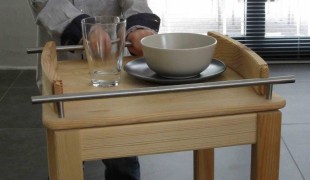- 9965
- 480
- 18
- 15
- 0
- Help Ukraine
About the solution
After seeing the experiences of friends and family, Anupam started working on something that would help with tremors and eating.
The devices rely on a technique that uses active cancellation hardware, which is currently used in noise-cancelling headphones. Anupam figured out how to make active cancellation hardware small enough to fit within the tremor-cancelling spoon. The utensil stops the bowl of the spoon from moving even while the handle itself may be trembling, which lets users can eat without spilling.
“Liftware Steady electronically stabilizes so the attached utensil shakes 70%* less than your hand”, says on the official website.
The entrepreneur discovered that today’s tremor-assistive devices usually attempt to cancel movement and for that reason are big, bulky, and inconvenient. “You don’t want to use things like that in public and they don’t even work that well at home. Our idea was not to stop the hand from shaking but to cancel its movement. That way, we can make our device really small, the size of an electric toothbrush, and you can use it every day.”
Liftware was founded in 2010 and was acquired by Verily, Alphabet Inc.’s life sciences research division, in 2014.
The company now produces and sell two gadgets: Liftware Steady, a device that was designed to help people with unintentional hand tremor and Liftware Level, a device designed for people with limited upper-extremity mobility.
These products can be bought online from 34,95 USD.
Adapted from: https://bit.ly/2Z1g8ZA
https://bit.ly/2KGHJGr
More info: https://www.liftware.com
https://www.youtube.com/watch?v=YNwfXeLlqsU
This solution shall not include mention to the use of drugs, chemicals or biologicals (including food); invasive devices; offensive, commercial or inherently dangerous content. This solution was not medically validated. Proceed with caution! If you have any doubts, please consult with a health professional.
DISCLAIMER: This story was written by someone who is not the author of the solution, therefore please be advised that, although it was written with the utmost respect for the innovation and the innovator, there can be some incorrect statements. If you find any errors please contact the patient Innovation team via info@patient-innovation.com
-
-
518
-
0
-
7682

Father creates stabilizer for his son
CAREGIVING
(SELF)-CARE: EATING: Eating independently.
(SELF)-CARE: DRINKING: Drinking independently.
Playing
Spinal Cord and Nerve Root Disorders
Cerebral Palsy
Neuromuscular Disorders
Assistive Daily Life Device (to help ADL)
Muscle cramps or spasms
Difficulty coordinating movements
Stiffness or rigidity (difficulty moving)
Paralysis of the legs and lower body
Muscle weakness
Managing Neurological Disorders
Preventing (Vaccination, Protection, Falls, Research/Mapping)
Caregiving Support
Neurology
Pediatrics
Belgium
-
-
-
562
-
17
-
15073

Woman invents cup to help her uncle who suffers from Parkinson’s disease
Grip
(SELF)-CARE: DRINKING: Drinking independently.
Parkinson's Disease
Muscle Tone Abnormalities weakness
Assistive Daily Life Device (to help ADL)
Gait abnormalities (e.g., walking difficulties, unsteady gait)
Tremors
Muscle cramps or spasms
Difficulty coordinating movements
Stiffness or rigidity (difficulty moving)
Muscle weakness
Loss of balance
Difficulty speaking or understanding speech
Memory loss
Sleep disturbances
Managing Neurological Disorders
Promoting inclusivity and social integration
Maintaining Balance and Mobility
Preventing (Vaccination, Protection, Falls, Research/Mapping)
General and Family Medicine
Medical Genetics
Neurology
Netherlands
-
-
-
461
-
2
-
6347

Students build device to help aunt who struggles with Parkinson’s disease
(SELF)-CARE: EATING: Eating independently.
(SELF)-CARE: DRINKING: Drinking independently.
Parkinson's Disease
Assistive Daily Life Device (to help ADL)
Gait abnormalities (e.g., walking difficulties, unsteady gait)
Tremors
Difficulty coordinating movements
Muscle weakness
Promoting self-management
Managing Neurological Disorders
Preventing (Vaccination, Protection, Falls, Research/Mapping)
Neurology
Singapore
-
 en
en